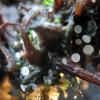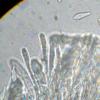
07-12-2025 16:07
Arnold BüschlenHallo, ich habe in einer Moos-Aufsammlung (epiohy

05-12-2025 17:33
 Bruno Coué
Bruno Coué
Bonjour, je serais heureux de recueillir votre avi

07-12-2025 09:24
De la pasada semana en Galicia EspañaEn el suelo

06-12-2025 00:19
 Viktorie Halasu
Viktorie Halasu
Hello, would anyone have this article, please? An

02-12-2025 18:59
This pair of ascos 2.5cm across were on recently b
On Salix catkin
Marja Pennanen,
14-05-2010 00:00
these grow on Salix catkin, but I've found them on Salix leaves, too.
They are near 1 mm wide and high.
Hans-Otto Baral,
14-05-2010 00:02

Re:On Salix catkin
Without micro and unable to enlarge the photo I think it is Pezizella amenti.
Marja Pennanen,
14-05-2010 00:07
Re:On Salix catkin
The spores are about 11-13x3,5-4,5, asci 60-75x7-9, IKI+ and paraphyses at top about 3 micrometers wide. The paraphyses have some decoration or guttuiles at the upper half.
When I found these, thoght, that I found some Hymenoscyphus species.
But I'm not very convinced of that now ;)
Marja with gifts from fungal wonderland
When I found these, thoght, that I found some Hymenoscyphus species.
But I'm not very convinced of that now ;)
Marja with gifts from fungal wonderland
Hans-Otto Baral,
14-05-2010 09:24

Re:On Salix catkin
o.k., amenti is clear. The placement in a genus is not clear in this species. It actually has some characters of a Hymenoscyphus, but it has also some gel, and it seems to be related to Cyathicula which has also these striking VB-guttules in the paraphyses (when you add KOH they disappear).
Zotto
Zotto
Marja Pennanen,
14-05-2010 11:45
Re:On Salix catkin
Dear Zotto,
thank you for a very fast answer. Actually you are so fast, that I never seem to be able to finish my description before you have answered :)
The species seems to be quite common, but all the same its new to me and very wellcome.
Marja
thank you for a very fast answer. Actually you are so fast, that I never seem to be able to finish my description before you have answered :)
The species seems to be quite common, but all the same its new to me and very wellcome.
Marja


